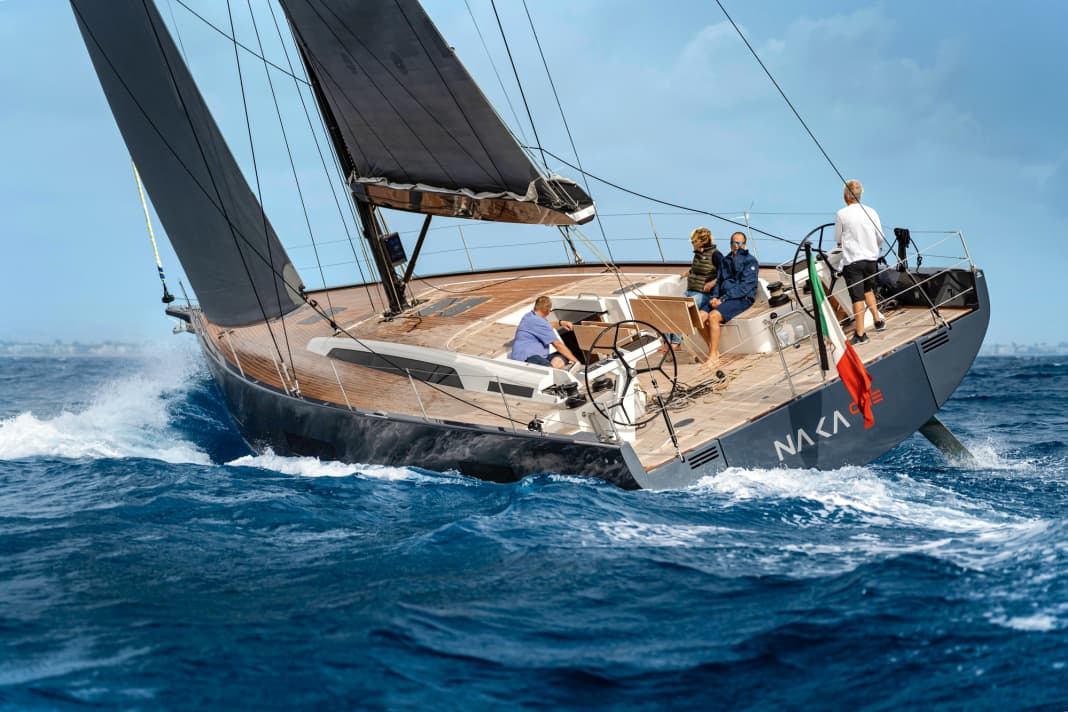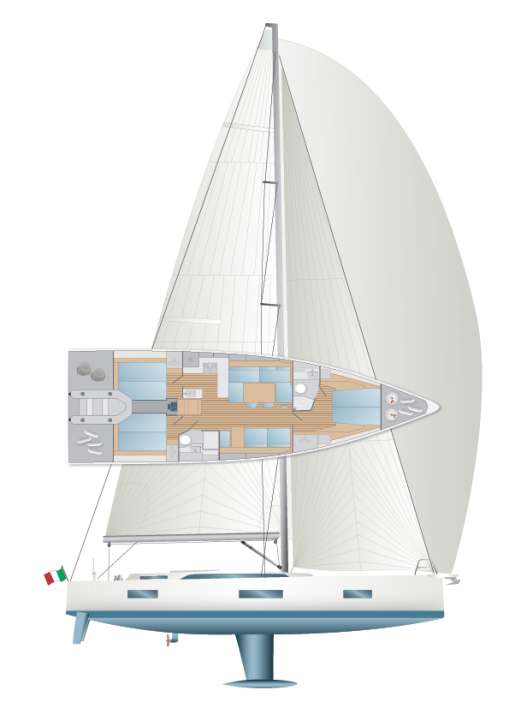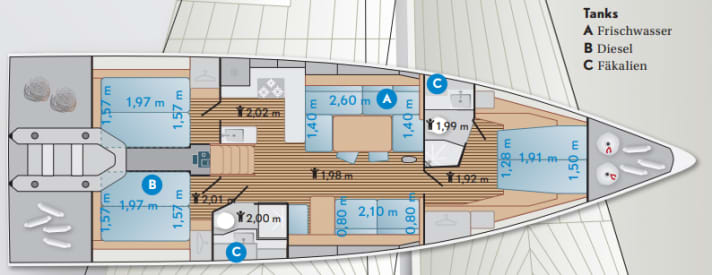





The shipyard has built and delivered almost 20 of the new Solaris 50 in just over a year. More than 40 further orders are currently on hand. That is a high benchmark, even for the competition. After all, this is a 15.50 metre long and very exclusive luxury cruiser, which will easily cost around a million euros or more in the wish-less-happy configuration. So things seem to be going splendidly, especially on the market for upmarket and expensive offers - despite the difficulties in post-pandemic times.
The yacht builders at Solaris in Aquileia on the Gulf of Trieste are now even producing the Solaris 50 in two complete mould sets in order to meet the high demand with reasonable delivery times. The hull and deck are produced as a GRP sandwich laminate with an Airex foam core, E-glass and vinyl ester resin. The large components are then compacted and cured under vacuum. The process and the materials are synonymous with very robust and rigid structural joints with good osmosis protection. And in the highly stressed areas, the fuselage and the structural floor assembly are additionally reinforced with carbon fibre inserts.
The new Solaris 50 appears as the successor to the equally successful model of the same name from the year 2015 (Test YACHT 3/2016). Although the change in model development remains manageable in direct comparison, it is nevertheless significant in parts. For example, the concept adopts the new deck layout, as already seen with the Solaris 60 and the Solaris 40 (YACHT 19/2021 test) has been implemented. As a novelty, the side decks no longer run all the way to the stern, but end on both sides in front of the steering columns. This creates a kind of walkaround cockpit. An additional step bridges the rather high step between the running deck and the cockpit floor. Jeanneau introduced the walkaround concept a good six years ago with the new generation of cruising yachts in its Sun Odyssey range. In the meantime, the good idea seems to have found imitators, now also at Solaris in a modified form.
Barrier-free passageways from the cockpit to the deck on board the Solaris 50
The fact is that the new cockpit design enables easy and largely barrier-free passageways from the cockpit to the deck and on to the foredeck. In addition, the steering columns can be positioned as far apart as possible, but with plenty of free space. This gives the helmsman more freedom of movement when working on the large wheels. He can easily reach the foredeck from his position, but can also work on the two large sheet winches, which are bolted to the running deck in front of the steering columns. The work processes are simple and clear, even for a small crew or single-handed sailors.
The disadvantage of the new Solaris layout is that because the side deck is not available aft, the helmsman no longer has a sensible place to sit. He therefore has to stand to steer, which gives him a good overview of the boat and sails, but is tiring in the long run. The small mouldings on the bulwark only provide limited relief as narrow stools, and only for occasional relief. As a reasonably good solution, however, the shipyard offers optional folding seats that can be attached to the side.
Solaris is based on the automotive industry
The term "Gran Turismo" comes from the automotive industry and describes the classic sports saloon - beautifully designed cars with powerful engines and sporty driving characteristics, but which also offer plenty of space and a high level of comfort when travelling. The boats of the latest model generations from Solaris Yachts also fulfil this ideal. The sporty and performance-orientated DNA remains the basis. Regatta suitability yes, but not only. The focus is also on easy handling and simple handling of the boat.
As with the Solaris 40, in the case of the new 50 this means in concrete terms: simple and central guidance of the mainsheet (single point sheeting), self-tacking jib as standard and the general guidance of all halyards, sheets and trim lines below deck to directly in front of the two helm stations. With the exception of a short genoa with hole points on deck, Solaris does not offer any significant variants. A traveller for the mainsheet, for example, is not available from the shipyard, even if sporty and active sailors would like one. The competition in its own country (Grand Soleil or Italia Yachts) is more flexible in terms of deck layouts and offers very different versions for its new model generations, both for sporty cruising and for ambitious regatta sailors travelling with a crew.
Test drive with the Solaris 50 off Barcelona
During the test off Barcelona in Spain, the YACHT editorial team had the opportunity to try out the new Solaris in very different conditions. At around 4 to 5 Beaufort, the racy Italian shows a strong performance on the wind. The powerful hull design by Argentinian designer Javier Soto Acebal offers noticeably high dimensional stability. The Solaris 50 sails stiffly and upright even in the gusts. Equipped with a self-tacking jib, the test boat, construction number one, runs at an above-average height. The turning angles are 80 degrees or even slightly less. The yacht manages 6.5 knots on the cross, and with the rollable Code Zero, the log comes close to double-digit values. However, the good performance values of the test boat must also be attributed to the carbon fibre rig from Hall Spars with textile shrouds and a high-quality set of performance sails - at least in part.
In less wind, however, the relatively high total weight of almost 16 tonnes quickly becomes noticeable. The Solaris 50 then seems rather sluggish and loses agility and dynamism in manoeuvres. While steering in windy conditions is a pleasure with a high fun factor, the feeling of steering is almost completely lost at only 2 Beaufort. This may be due to the double rudder blades, but also to the unusually extensive and high-quality design of the steering system. Although the mechanics work very precisely with chain hoists, angular gears and push rods and offer a high level of redundancy, they are also somewhat stiff with more resistance in the system.
Calm below deck
The unusual quietness below deck is striking. Hardly anything can be heard from the waves when sailing, and even during manoeuvres it remains surprisingly quiet inside. This is partly due to the perfect insulation of the technical installations and fittings, and partly to the high-quality manufacture of the hull and deck, as well as the furniture.
The standard of fittings below deck is first class. In addition to the impeccable workmanship of the components in all areas, it is the many small details that are particularly impressive, especially in the on-board installations. The technical parts are perfectly accessible, installed in an understandably sensible manner and come from the suppliers' high-end ranges.
In terms of the design below deck, Solaris is also taking the conventional route with the new model and is essentially adopting the layout of the previous version. The classic layout with three double cabins and two heads with separate shower remains. The only variation is that the double bed in the forward cabin can also be arranged sideways. In this case, the bathroom is fitted between the foredeck and forepeak across the entire width of the ship and offers more space than in the standard layout, especially in the shower.
Compared to the previous model, the hull of the new Solaris 50 is wider and the stern is fuller. This has made it possible for the planners to provide two rectangular double berths aft with a continuous width of 1.57 metres. The garage for the longitudinally mounted dinghy protrudes a little into the aft cabins, but well above the berth areas, which therefore still have the full comfort dimensions.
Customers can have a say in the interior design of the Solaris 50
As is usual with Solaris, the customer can help design the look of the interior. There is a choice of different types of wood as well as various materials and colours for the upholstery.
Solaris Yachts builds boats that are at the top of many sailors' wish lists. In addition to the exciting look, it is the high quality that inspires and the good sailing characteristics that impress. Because good things don't come for free, the Solaris 50 naturally comes at a high price: the price tag for the basic version without the sails is just under 780,000 euros. That's a lot of money - but also for a lot of good ship.
Measurement results





Technical data
- Design engineer:Javier Soto Acebal
- CE design category: A
- Torso length: 15,50 m
- Overall length with bowsprit: 16,75 m
- Waterline length: 14,68 m
- Width:4,78 m
- Draught/alternate..: 2,80/2,60/2,35 m
- Mast height above WL: 23,00 m
- Theor. torso speed:9.3 kn
- Weight: 15,9 t
- Ballast/proportion:4,85 t/30,5 %
- Mainsail: 84,70 m²
- Furling genoa (106 %): 70,30 m²
- machine (Volvo P.): 36 kW/50 hp
- Fuel tank (stainless steel): 370 l
- Fresh water tanks (PVC): 510 l
- Holding tank (PVC): 2x 60 litres
- Batteries:AGM 12 V/345 Ah (total)


Hull and deck construction
GRP sandwich with PVC foam core, E-glass and vinyl ester resin. Laminate in a vacuum process. Fuselage reinforcements made of carbon fibre
Equipment and prices
- Base price ex shipyard: 779.450
- Price ready to sail: 2859.220 €
- Guarantee/against osmosis: 2/2 years
Teak on deck
Standard on the cockpit floor and on the dents. Optional on running deck and superstructure. Esthec is possible
Sailing
As is usual with performance cruisers, the sails are not included in the basic price. A single set of sails (main and self-tacking jib) will cost at least an additional 40,000 euros
Rig and options
Aluminium rig with three spreaders and stainless steel wire shrouds (1 x 19). The carbon fibre rig from Hall Spars, as on the test boat, costs around 188,000 euros extra
Motorisation
Standard: Volvo Penta D2-50 four-cylinder built-in diesel with saildrive and three-blade fixed pitch propeller. A Volvo Penta D2-75 can also be installed as an option
Shipyard
Solaris Yachts srl, 33051 Aquileia (Italy); www.solarisyachts.com
Distribution
Dealer network
YACHT rating
The latest boat from Solaris Yachts remains uncompromisingly true to the shipyard's brand values. The boat has a very straightforward appearance, but at the same time is not rich in variation. The build quality is top league and the finish below deck is immaculate
Design and concept
- + Very solid construction
- + A visual treat
- + Functional cockpit layout
- - Little variance
Sailing performance and trim
- + Very good height in the wind
- + Sails very lively in windy conditions
- + Suitable for one-handed handling
- - Helmsman must stand
Living and finishing quality
- + Very high fit-out standards
- + Forebody in two versions
- + Beautiful, bright ambience
- - Bunk forward not seaworthy
Equipment and technology
- + Dinghy lengthways in garage
- + High-quality basic equipment
- + Lots of storage space on deck
- - Controls rather stiff

